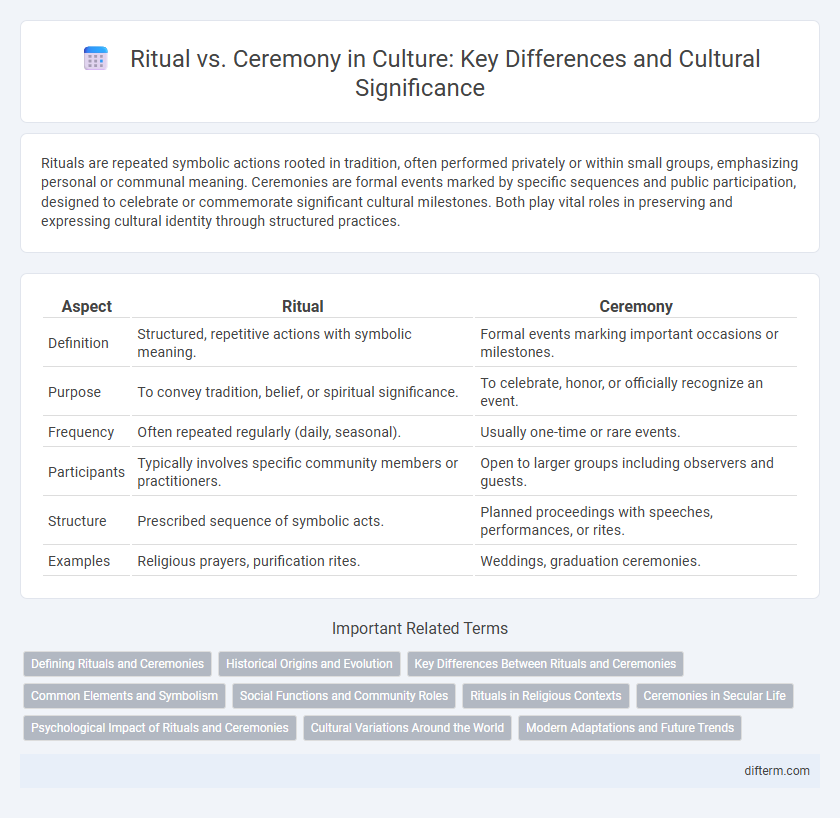Rituals are repeated symbolic actions rooted in tradition, often performed privately or within small groups, emphasizing personal or communal meaning. Ceremonies are formal events marked by specific sequences and public participation, designed to celebrate or commemorate significant cultural milestones. Both play vital roles in preserving and expressing cultural identity through structured practices.
Table of Comparison
| Aspect | Ritual | Ceremony |
|---|---|---|
| Definition | Structured, repetitive actions with symbolic meaning. | Formal events marking important occasions or milestones. |
| Purpose | To convey tradition, belief, or spiritual significance. | To celebrate, honor, or officially recognize an event. |
| Frequency | Often repeated regularly (daily, seasonal). | Usually one-time or rare events. |
| Participants | Typically involves specific community members or practitioners. | Open to larger groups including observers and guests. |
| Structure | Prescribed sequence of symbolic acts. | Planned proceedings with speeches, performances, or rites. |
| Examples | Religious prayers, purification rites. | Weddings, graduation ceremonies. |
Defining Rituals and Ceremonies
Rituals are structured, symbolic acts performed consistently within cultural or religious contexts, often to convey meaning or facilitate social cohesion. Ceremonies are formal events that incorporate rituals to mark significant occasions or transitions, such as weddings or initiations. Both rituals and ceremonies serve to reinforce cultural identity and collective values through prescribed behaviors and symbolic gestures.
Historical Origins and Evolution
Rituals have deep historical origins rooted in ancient spiritual and religious practices designed to invoke divine powers or mark significant life events, evolving over millennia across diverse cultures. Ceremonies emerged as structured social events often linked to community identity and governance, formalizing collective values and traditions through symbolic acts. Both practices exhibit dynamic evolution, adapting to changing cultural norms while preserving essential elements that reinforce group cohesion and cultural heritage.
Key Differences Between Rituals and Ceremonies
Rituals are structured actions often performed for spiritual or symbolic purposes, emphasizing repeated patterns and personal or communal meaning, while ceremonies are formal events that mark significant social occasions with prescribed protocols and public participation. Rituals tend to be intimate and internally focused, involving elements such as prayers, gestures, or symbolic tokens, whereas ceremonies often involve broader social recognition, including speeches, music, and official procedures. Understanding the distinction highlights how rituals nurture individual or group identity, while ceremonies consolidate community bonds and cultural heritage.
Common Elements and Symbolism
Rituals and ceremonies share common elements such as structured sequences of actions, symbolic gestures, and specific settings that convey cultural meanings. Both utilize symbols--objects, words, or actions--that represent deeper values, beliefs, or social bonds within a community. These symbolic components reinforce identity, tradition, and shared understanding across generations.
Social Functions and Community Roles
Rituals often serve as personalized or smaller-scale practices that reinforce social bonds and cultural values within tight-knit groups, emphasizing symbolic actions that connect individuals to shared beliefs. Ceremonies typically involve formal, public events marking significant social milestones, promoting collective identity and cohesion across broader community boundaries. Both play crucial roles in maintaining social order and transmitting cultural heritage by facilitating roles, statuses, and community participation.
Rituals in Religious Contexts
Rituals in religious contexts serve as structured actions imbued with symbolic meaning, reinforcing faith and community bonds through repeated practices such as prayer, sacraments, or purification rites. These actions transcend mere tradition by actively embodying spiritual beliefs, often prescribed by sacred texts or religious authorities to maintain doctrinal consistency. Unlike ceremonies, which may be more formal or celebratory, rituals emphasize participation and transformation, playing a crucial role in individual and collective religious identity.
Ceremonies in Secular Life
Ceremonies in secular life mark significant moments such as graduations, weddings, and national holidays, serving as structured events that reinforce communal identity and social values. These ceremonies often involve symbolic acts, formal procedures, and collective participation without religious connotations, emphasizing cultural heritage and societal norms. The secular ceremony functions as a public ritual that fosters unity and continuity within diverse communities.
Psychological Impact of Rituals and Ceremonies
Rituals often create a deep psychological sense of belonging and stability by engaging repetitive, meaningful actions that reinforce identity and emotional connection, while ceremonies typically mark significant transitions and foster communal recognition of change. The predictability and symbolic nature of rituals help reduce anxiety and improve mental resilience, whereas ceremonies provide a structured framework for processing grief, joy, or achievement, enhancing collective emotional healing. Both rituals and ceremonies activate neural pathways linked to reward and social bonding, amplifying their impact on mental well-being and group cohesion.
Cultural Variations Around the World
Rituals and ceremonies exhibit diverse cultural variations worldwide, reflecting unique social values and traditions in societies from indigenous tribes to modern nations. Rituals often involve repeated symbolic actions with spiritual significance, such as the Japanese tea ceremony's precise movements symbolizing harmony and respect. Ceremonies, like Indian weddings, combine multiple rituals to mark significant life events, highlighting communal identity and cultural heritage across different regions and religions.
Modern Adaptations and Future Trends
Modern adaptations of rituals emphasize personalized, inclusive experiences that blend traditional elements with contemporary values, reflecting evolving cultural dynamics. Ceremonies increasingly integrate digital technologies such as virtual reality and livestreaming to enhance participation and accessibility in global communities. Future trends suggest a convergence of ritualistic symbolism and technological innovation, fostering hybrid practices that resonate with diverse identities and environmental consciousness.
Ritual vs Ceremony Infographic

 difterm.com
difterm.com